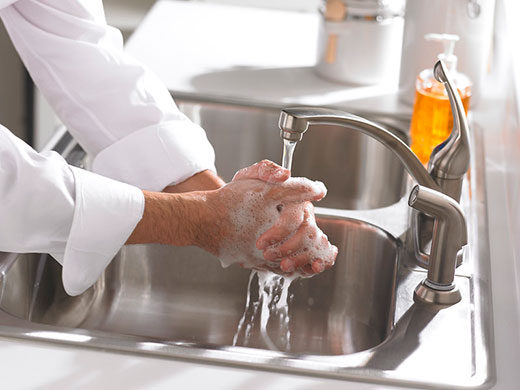
While many of us are spending more time at home, this may be the best time to review basic food safety practices for everyone in the family.
More time in the kitchen makes this a good time to review food safety tips
Always start with clean hands and surfaces, specialists say
April 10, 2020
MANHATTAN, Kan. – Whether we planned to or not, many of us are spending more time at home because of the new coronavirus outbreak, and that likely means more time in the kitchen.
Now may be the best time to learn or review safe food handling practices and the reasons behind them, aimed at keeping foodborne illnesses at bay.
Kansas State University food safety specialists say the four main concepts include:
1) Clean. Wash hands and surfaces often.
2) Chill. Refrigerate promptly.
3) Separate. Don’t cross-contaminate.
4) Cook. Cook to proper temperatures.
“Wash your hands often,” said Karen Blakeslee, K-State Research and Extension food safety specialist. “Use water and any soap, rub your hands together for at least 20 seconds, rinse with water and dry with a clean towel. The soap bubbles and rubbing are your best defense for clean hands.”
Food safety details, including information about those sometimes confusing “sell by” and “use by” dates on food packaging are included in a K-State Research and Extension fact sheet, At-Home Safe Food Handling: It’s in Your Hands, available online. Tips include:
- Grocery shopping – If running several errands, shop for food last to avoid leaving it too long in a (sometimes) hot car. Keep meat, poultry, fish or seafood separate from other food items in the cart.
- Storing – Keep refrigerator at 40 degrees F. or colder to slow bacterial growth.
- Cooking – Cook food thoroughly to kill any bacteria. Use a food thermometer to help determine doneness.
- Serving – Keep raw and cooked meat, poultry, fish or seafood separate. Never place cooked foods on an unwashed plate that previously held raw meat, poultry, fish, or seafood. Refrigerate leftover food within two hours of preparing, serving and eating.
- Leftovers – Divide large amounts of leftover foods, such as soup, into shallow containers for quicker cooling.
If there are children at home, this is a great time to not only include them in preparing meals and snacks, but also to teach them how and why it’s important to handle food properly and safely.
“Even though there is currently no evidence that COVID-19 is transmitted through food or food packaging, it is always important to use good food safety practices, which will help control foodborne illness, as well as COVID-19,” said extension food safety specialist Londa Nwadike.
In addition to the fact sheet, more information is available on the Extension Food Safety page. K-State Research and Extension offices across the state also have training and resources available on this and a range of topics.
